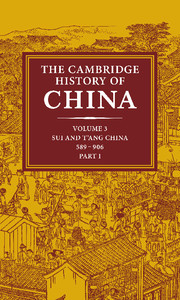Book contents
- Frontmatter
- 1 Introduction
- 2 The Sui dynasty (581–617)
- 3 The founding of the T'ang dynasty: Kao-tsu (reign 618–26)
- 4 T'ai-tsung (reign 626–49) the consolidator
- 5 Kao-tsung (reign 649–83) and the empress Wu: the inheritor and the usurper
- 6 The reigns of the empress Wu, Chung-tsung and Jui-tsung (684–712)
- 7 Hsüan-tsung (reign 712–56)
- 8 Court and province in mid- and late T'ang
- 9 Court politics in late T'ang times
- 10 The end of the T'ang
- Glossary Index
- References
6 - The reigns of the empress Wu, Chung-tsung and Jui-tsung (684–712)
Published online by Cambridge University Press: 28 March 2008
- Frontmatter
- 1 Introduction
- 2 The Sui dynasty (581–617)
- 3 The founding of the T'ang dynasty: Kao-tsu (reign 618–26)
- 4 T'ai-tsung (reign 626–49) the consolidator
- 5 Kao-tsung (reign 649–83) and the empress Wu: the inheritor and the usurper
- 6 The reigns of the empress Wu, Chung-tsung and Jui-tsung (684–712)
- 7 Hsüan-tsung (reign 712–56)
- 8 Court and province in mid- and late T'ang
- 9 Court politics in late T'ang times
- 10 The end of the T'ang
- Glossary Index
- References
Summary
THE PERIOD OF PREPARATION (684–90)
The fourth T'ang emperor, who ascended the throne as Chung-tsung in the twelfth month of 683, was only the third son of Kao-tsung and the empress Wu. Since his chances for the succession had always seemed remote, he had been prepared neither by upbringing nor by his brief three years as heir apparent for his new dignity, and it was probably for this reason that his father's will had provided for the continuing political influence of the experienced empress Wu. Her intervention, strictly speaking, was to be permitted only ‘where matters could not be decided’, but she lost no time in showing that an honoured but impotent retirement as empress dowager was far from her mind. The first sign of this was her contravention of the will's provision that Chung-tsung should succeed immediately ‘in front of the coffin’; and in delaying the coronation a full week, she revealed both her own ambition, and the fact that she felt certain misgivings about her son's suitability. Too little is known of the character of the new emperor to make judgments on the validity of his mother's suspicions, but it is clear even at this stage of his career, that he had inherited at least one of his father's weaknesses, and had fallen under the domination of his own wife, the empress Wei. Within a month of his accession, he promoted her father, Wei Hsüan-chen, to the rank of chief minister.
- Type
- Chapter
- Information
- The Cambridge History of China , pp. 290 - 332Publisher: Cambridge University PressPrint publication year: 1979
References
- 4
- Cited by



